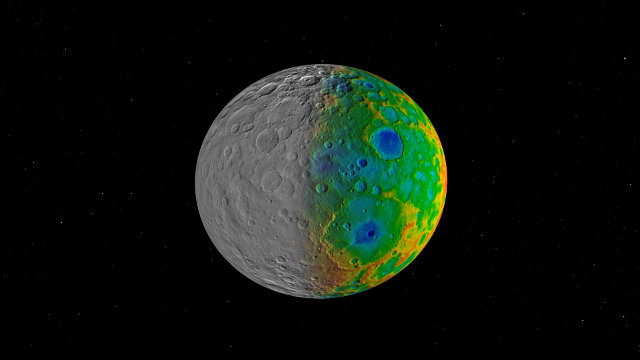
An article published in the journal “Nature Communications” describes a research on the craters found on the surface of the dwarf planet Ceres by NASA’s Dawn space probe. A team of scientists led by Simone Marchi of the Southwest Research Institute in Boulder argues that there are fewer large craters than expected and the reason is that were obliterated.
The researchers compared the large craters seen by the Dawn space probe with those predicted by theoretical models on collisions. On Ceres there are only 16 craters with a diameter greater than 100 kilometers (about 60 miles) and none with a diameter greater than 280 kilometers (about 175 miles). According to the theoretical models should there be between 10 and 15 with a diameter greater than 400 kilometers (about 250 miles) and at least 40 more with a diameter greater than 100 kilometers. Things don’t add up.
The amount but also the distribution of craters on a celestial body are useful to scientists to reconstruct their history. In the case of the dwarf planet Ceres, it’s estimated to have formed around 4.55 billion years ago when the solar system was just born. At that time and for many more millions of years the enormous amount of asteroids led to countless collisions and in some cases those were very large asteroid or even protoplanets.
On Ceres a lot of small craters were observed but there are very few big ones, also considering its location in the asteroid belt between Mars and Jupiter. We can also make a comparison with the giant asteroid Vesta, the second largest celestial body of that belt, because it was visited by the Dawn space probe before reaching Ceres. Well, Vesta is covered by huge craters and the largest one covers almost entirely one of its hemispheres.
According to one theory, actually Ceres formed in the outer area of the solar system, perhaps close to Neptune, and was subsequently pushed inward by the gravity of one of the largest planets. However, even in that case the researchers would expect that on its surface there was a significant amount of large craters.
According to the researchers, the explanation is that many large craters were present in the past but over time were obliterated. A clue is given by some now faint traces, hidden beneath the surface of Ceres, three basins called very large planitiae that could be ancient craters almost completely obliterated. Even in these planitiae there are small craters but the large depressions may be the remains of large impacts.
One of the causes of the craters disappearance could be the possible presence of ice or other low viscosity materials in Ceres’ subsurface. Another possibility is the presence of cryovolcanoes whose activity filled the craters. However, these are not very efficient processes to eliminate traces of very large craters.
An interesting possibility is linked to a recently published research concerning the possible presence in the past of an liquid water in Ceres’ underground. The ancient hydrothermal activity might be related to geological processes that have renewed the dwarf planet’s surface over time, obliterating the craters.
In any case, those are new directions on the fact that at least in the past on Ceres there was a significant geological activity. It’s the reason why research on the processes occurred or still active on the dwarf planet keep on being made by examining the data that the Dawn space probe has sent and is sending.


